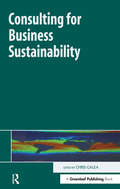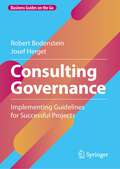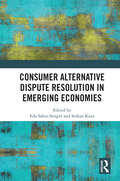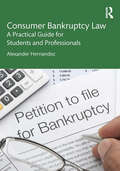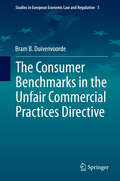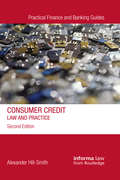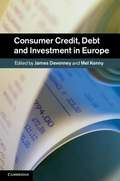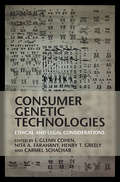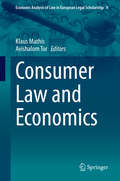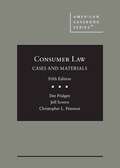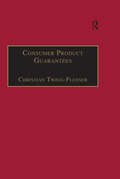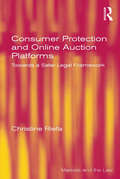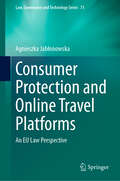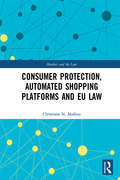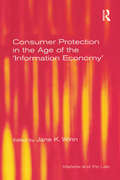- Table View
- List View
Consultant and Independent Contractor Agreements (6th edition)
by Stephen FishmanConsultant and Independent Contractor Agreements provides legal and practical advice on how to write a clear, solid legal agreement. It also explains how to define current projects, establish deadlines, avoid disputes, set fees and satisfy IRS requirements. The book includes tear-out agreements and a CD-ROM with over 15 agreements tailored to the most popular fields for independent contractors. The 6th edition is revised and updated and now includes a checklist that helps business owners determine whether someone should be classified as an employee or independent contractor.
Consultant & Independent Contractor Agreements
by Stephen FishmanDesigned for both independent contractors and the businesses who hire them, Consultant & Independent Contractor Agreements is the most comprehensive guide you’ll find anywhere. The book shows you how to: define the scope and duration of the work to be performed protect trade secrets, trademarks, patents, and copyrights satisfy IRS and other government agency requirements establish pay and other compensation avoid disputes. The new edition is completely updated to provide the latest rules and regulations for businesses and contractors. It includes step-by-step guidance and all the forms you'll need to draw up the necessary contracts.
Consultant & Independent Contractor Agreements
by Stephen FishmanGet your contract in writing With the rise of the gig economy, independent contractor arrangements are more common than ever. Whether you’re an independent contractor or a business hiring one to work for you, a written agreement will help to protect your rights, define expectations, and prove that there’s no employer-employee relationship. Here you’ll find specific agreements for many types of independent contractors and freelancers, including salespeople, accountants, software consultants, and construction contractors. You’ll learn how to: draft a binding agreement define a project’s scope preserve confidentiality distinguish between employees and independent contractors protect your intellectual property amend your agreement, and satisfy IRS requirements. Each chapter has two agreements—one geared towards the independent contractor and one geared towards the business hiring an independent contractor. The 10th edition—completely updated to provide the latest rules and regulations—includes a useful chapter on agreements for gig workers. With downloadable forms: download all the forms you need to draw up a solid contract (details inside).
Consultant & Independent Contractor Agreements
by Stephen FishmanDesigned for both independent contractors and the businesses who hire them, Consultant & Independent Contractor Agreements is the most comprehensive guide you'll find anywhere. The book shows you how to: define a project's scope, components, and duration protect trade secrets, trademarks, patents, and copyrights satisfy IRS requirements get paid on time and in full avoid disputes The new edition is completely updated to provide the latest rules and regulations for businesses and contractors. It includes step-by-step guidance and all the forms you'll need to draw up the necessary contracts.
Consulting for Business Sustainability: A Special Themed Issue Of Greener Management International (issue 54)
by Chris GaleaThe fast-emerging sustainability consulting firms are nipping at the heels of the established consultancy giants who are scrambling to find their way in the emergent field of sustainability. The upstarts are challenging many of the established notions of how to add value to their clients' operations. By looking at the business world through what the sustainability expert Stuart Hart calls "new sustainability lenses", sustainability consultants are able to make sense of challenges that are baffling their clients. Moreover, they are also beginning to help their clients uncover new and sustainable value streams, the ultimate goal of good consulting practice. In Consulting for Business Sustainability sustainability consultants from around the world offer some of their perspectives and lessons on how to truly create sustainable value for their clients. Packed with new tools, advice and approaches, the book comprises a unique collection of wisdom from some of the leading lights in sustainability consulting practice. The areas covered include: developing best-in-class environmental management systems; sustainable design; supporting organisational change agents; working with key stakeholders; social impact assessments; human rights; and regulatory risk. The book will be essential reading for practitioners in business searching for advice and toolkits on how to make their sustainability initiatives bear fruit, for consultants looking for advice on how others have provided value to clients, and for students of sustainability looking for best-practice examples and exploring future careers in this burgeoning field.
Consulting Governance: Implementing Guidelines for Successful Projects (Business Guides on the Go)
by Robert Bodenstein Josef HergetEvery consulting project has its governance, which is not always explicitly agreed with the client. This book describes the fundamentals of governance in consulting projects and explains the concept and the concrete implementation in practice. It describes the individual elements of consulting governance and illustrates the implementation with practical examples, accompanied by frameworks, reference models, roadmaps and checklists that facilitate the transfer into practice. In addition, the opportunities and risks of consulting governance are presented from the perspective of both the consulting client and the service provider, and the future of international developments of governance consulting are highlighted.The book is aimed at consultants, coaches, trainers and mediators as well as executives and project managers who are responsible for the implementation of consulting projects.
Consumer Alternative Dispute Resolution in Emerging Economies
by Eda Sahin-Sengül Serkan KayaThis book provides a comprehensive guide to consumer Alternative Dispute Resolution (ADRs) and the unconventional challenges they pose for emerging economies, aiming to advance their growth within developing nations.Written in response to the increasing number of transactions between consumers and traders in the digital age, and the accompanying rise in consumer disputes, the book details ADR systems which have come to the fore to settle complaints. Covering ADR techniques including arbitration, mediation and ombudsman services, it provides a guide to efficient dispute resolution and its application to emerging economies worldwide. The book also examines the role of technology in shaping ADR processes, given the prevalence of digital transactions in consumer markets.Thoughtfully explaining the challenges faced in implementing these systems suggests how governments and businesses can encourage the use of ADR, alongside providing practical case studies detailing past integrations into emerging economies.Practical, thorough, and internationally focused, this book will be of interest to researchers in the fields of dispute resolution, consumer law, and technology.
Consumer Bankruptcy Law: A Practical Guide for Students and Professionals
by Alexander HernandezThis practical and invaluable textbook covers the principles and practice of U.S. consumer bankruptcy law, known as Chapter 7 and Chapter 13, for paralegals and legal studies students. Consumer Bankruptcy Law provides step-by-step guidance on handling a bankruptcy case, from client interviews to preparing and filling the bankruptcy petition, as well as the issues which may arise after. Featuring practical examples throughout, the book ensures that you will become familiar not only with core legal concepts but also with the real-life issues and pitfalls that can occur. Screenshots on how to complete a bankruptcy petition are featured, along with flowcharts of the processes of consumer bankruptcy law in the U.S. and exercises to test your knowledge at the end of each chapter. Including online resources for both students and instructors to benefit from, such as multiple-choice questions and PowerPoints summarizing each chapter, Consumer Bankruptcy Law: A Practical Guide for Students and Professionals will be an indispensable resource for anyone engaging in this important area of legal practice.
The Consumer Benchmarks in the Unfair Commercial Practices Directive
by Bram B. DuivenvoordeThis book investigates the regime of consumer benchmarks in the Unfair Commercial Practices Directive and explores to what extent this regime meets each of the goals of the Directive. In particular, it assesses whether the consumer benchmarks are suitable in terms of achieving the three goals of the Directive: achieving a high level of consumer protection, increasing the smooth functioning of the internal market, and improving competition in the market as such. In addition to providing a thorough analysis of the consumer benchmarks and their relationship to the goals of the Directive, at a more practical level, the book provides insight into the working and consequences of the benchmarks that can be used in the evaluation of the Unfair Commercial Practices Directive and its application by the CJEU. This assessment is important because the Directive, while promising to regulate unfair commercial practices in a way that achieves the Directive's goals, has removed the possibility for Member States to regulate unfair commercial practices themselves.
Consumer Casualties
by Junmin WanJunmin Wan takes a two prong approach to analysing this pressure in Japan in his new volume Consumer Casualties. He first clarifies the consumer preference for habit to identify useful approaches toward solving a number of economic issues, such as gambling and other addictive practices.
Consumer Credit: Law and Practice (Practical Finance and Banking Guides)
by Alexander Hill-SmithThe field of consumer credit law has undergone major and fundamental change in the recent past, due in part to the regulation since 1 April 2014 of consumer credit by the Financial Conduct Authority, and this book provides a clear and complete guide to this difficult area of law. Fully updated for the second edition, the author considers new developments including: the new authorisation process under the Financial Services and Markets Act 2000, including the interim permission regime, and its consequences; the new regime for financial promotions as applied to credit and hire advertising; the new rules controlling high cost short term lending and peer to peer lending; the new provisions of the recently released Consumer Credit Sourcebook (CONC); the new requirements governing mortgage lending as contained in MCOB; the requirements for distance selling and off-premises contracts as applied to consumer credit and consumer hire including the impact of the Consumer Contracts (Information, Cancellation and Additional Charges) Regulations 2013; the jurisdiction of the financial ombudsman service on consumer credit. Also considered is the recent case law on the powerful unfair relationships jurisdiction. This comprehensive and practical guide is essential reading for legal practitioners, finance houses, credit reference agencies and retail organisations.
Consumer Credit, Debt and Investment in Europe
by James Devenney Mel KennyProduced under the auspices of an EU-funded Marie Curie research programme, this volume analyses vulnerability in European private law and scrutinises consumer protection in credit and investments in the context of the recent turmoil in financial markets and EU harmonisation initiatives in the area. It explores key issues such as responsible lending, the disclosure of information, consumer confidence, the regulation of consumer investment services and the protection of bank depositors. The chapters emanate from the 'Consumer Protection in Europe: Theory and Practice' duo colloquium which explored consumer protection in Europe in its theoretical and practical dimensions. These topics are even more relevant today given the passage of the Consumer Rights Directive, the appointment of an Expert Group on a common frame of reference, the Green Paper on European Contract Law and the ongoing deliberations surrounding the Common European Sales Law.
Consumer Debt and Social Exclusion in Europe (Markets and the Law)
by Hans-W. Micklitz Irina DomurathThis book analyses the dichotomy between the goal of social inclusion and the effect of social exclusion through over-indebtedness since 2008 in Europe. Filling a vital gap in the current literature on the effects of the financial and economic crisis, this volume puts into context academic discussion with the real-life dimension of over-indebtedness. Reports from six European countries provide socio-economic and legal information on over-indebtedness as well as the regulatory and judicial responses to the problems entailed by over-indebtedness. They form the empirical background for five analyses of different aspects of the inclusion-exclusion dichotomy. It becomes clear that in the context of credit expansion, individual over-indebtedness has turned into a social issue, which the current design of the consumer credit and mortgage system in Europe has helped to produce while disregarding the consequential danger of social exclusion.
Consumer Financial Dispute Resolution in a Comparative Context
by Shahla F. AliNearly all major global financial centres have developed systems of consumer financial dispute resolution. Such systems aim to assist parties to resolve a growing number of monetary disputes with financial institutions. How governments and self-regulatory organizations design and administer financial dispute resolution mechanisms in the context of increasingly turbulent financial markets is a new area for research and practice. Consumer Financial Dispute Resolution in a Comparative Context presents comparative research about the development and design of these mechanisms in East Asia, North America and Europe. Using a comparative methodology and drawing on empirical findings from a multi-jurisdictional survey, Shahla Ali examines the emergence of global principles that influence the design of financial dispute resolution models, considers the structural variations between the ombuds and arbitration systems and offers practical proposals for reform.
Consumer Genetic Technologies: Ethical and Legal Considerations
by I. Glenn Cohen Nita A. Farahany Henry T. Greely Carmel ShacharFor the average person, genetic testing has two very different faces. The rise of genetic testing is often promoted as the democratization of genetics by enabling individuals to gain insights into their unique makeup. At the same time, many have raised concerns that genetic testing and sequencing reveal intensely personal and private information. As these technologies become increasingly available as consumer products, the ethical, legal, and regulatory challenges presented by genomics are ever looming. Assembling multidisciplinary experts, this volume evaluates the different models used to deliver consumer genetics and considers a number of key questions: How should we mediate privacy and other ethical concerns around genetic databases? Does aggregating data from genetic testing turn people into products by commercializing their data? How might this data reduce or exacerbate existing healthcare disparities? Contributing authors also provide guidance on protecting consumer privacy and safety while promoting innovation.
Consumer Law and Economics (Economic Analysis of Law in European Legal Scholarship #9)
by Klaus Mathis Avishalom TorThis edited volume covers the challenges currently faced by consumer law in Europe and the United States, ranging from fundamental theoretical questions, such as what goals consumer law should pursue, to practical questions raised by disclosure requirements, the General Data Protection Regulation and technology advancements. With governments around the world enacting powerful new regulations concerning consumers, consumer law has become an important topic in the economic analysis of law. Intended to protect consumers, these regulations typically seek to do so by giving them tools to make better decisions, or by limiting the consequences of their bad decisions. Legal scholars are divided, however, regarding the efficacy and effects of these regulations; some call for certain policies to be abolished, while others support a regulatory expansion.
Consumer Law and Protection: Protecting the Rights of Consumers
by Neal BevansIn recent years, the interest in consumer-related issues has grown tremendously, fueled by growing unemployment, high foreclosure rates, credit card interest rate increases and a recession more sweeping than anything seen in more than a generation. Unfortunately, when readers look for a text to explain these issues, they are too often confronted with case books that have more application to law school curricula than to a college-level course. This book fills the need for a well-written text on consumer law and consumer protection. <p><p>Covering topics as diverse as protecting a person's credit rating to avoiding predatory lending, Consumer Law & Protection explains the law and gives readers the tools that they need to protect themselves from telemarketers, unscrupulous debt collectors and network marketing schemes, to name only a few of the topics covered in the book.
Consumer Law and Socioeconomic Development: National and International Dimensions
by Dan Wei Claudia Lima MarquesThis book reflects the research output of the Committee on the International Protection of Consumers of the International Law Association (ILA). The Committee was created in 2008, with a mandate to study the role of public and private law to protect consumers, review UN Guidelines, and to model laws, international treaties and national legislations concerning protection and consumer redress. It has been accepted to act as an observer not only when the UNCTAD was updating its guidelines, but also at the Hague Conference on Private International Law. The book includes the contributions of various Committee members in the past few years and is a result of the cooperation between the Committee members and experts from Australia, Brazil, Canada and China. It is divided into three parts: the first part addresses trends and challenges in international protection of consumers, while the second part focuses on financial crises and consumer protection and the third part examines national and regional consumer law issues.
Consumer Law, Cases and Materials (American Casebook Series)
by Dee Pridgen Jeff Sovern Christopher PetersonCases and Materials on Consumer Law (5th Ed.) retains its comprehensive coverage and has been completely updated to reflect new developments in the dynamic field of consumer law, including: Internet marketing, ad substantiation, celebrity and other testimonials, and new developments in online consumer contractsConsumer credit regulation, including new Supreme Court cases dealing with credit reporting and debt collection, as well as the latest developments with the Consumer Financial Protection BureauConsumer privacy, including the new California Consumer Privacy Act, the Internet of Things, biometrics, online marketing, cybersecurity and new developments concerning the Telephone Consumer Protection ActDeveloping and emerging payment systems – e.g., credit, debit, and prepaid cards, as well as mobile payments, digital wallets, and cryptocurrencyRemedies – latest U.S. Supreme Court and regulatory developments on consumer arbitration and class actionsPredatory lending (“capstone” chapter), the legal fallout from the subprime mortgage foreclosure crisis and beyond Student loan disclosures, collections and servicing; and deceptive school admissions marketing to prospective students This text contains a balance of cases, problems that reflect modern situations, and notes with discussion questions and references to the latest consumer protection scholarship.
Consumer Product Guarantees
by Christian Twigg-FlesnerThis book presents a detailed analysis of the function of consumer product guarantees and the related legal issues. It applies research findings from the fields of consumer complaining behaviour, marketing science and economics to the legal context. Its central argument is that guarantees could be one way of assisting consumers in resolving product quality disputes. Consumers tend to seek to resolve such disputes informally by complaining, rather than by seeking to go through the courts or structured forms of alternative dispute resolution. Such complaints can be supported by encouraging reliance on consumer product guarantees, particularly where consumers also enjoy strong legal rights. With this in mind, the book develops a legal framework for consumer guarantees, which is based on two key principles: fairness and transparency. There then follows an analysis of English and EC provisions on guarantees, as well as of relevant US law. Particular consideration is given to the relationship between consumer guarantees and statutory rights.
Consumer Product Safety (Routledge Revivals)
by Geraint G. HowellsPublished in 1998, this book seeks to analyse in a comparative framework laws relating to product safety. These include standard setting, general safety obligations, (enforcement agencies), recall of products, export control, product accident monitoring and information exchange systems. The countries studied will include UK, USA, Canada, France, Germany, Sweden, Australia, New Zealand, as well as EC law in the light of the recent EC product safety directives.
Consumer Protection and Online Auction Platforms: Towards a Safer Legal Framework (Markets and the Law)
by Christine RiefaOnline auctions have undergone many transformations and continue to attract millions of customers worldwide. However these popular platforms remain understudied by legal scholars and misunderstood by legislators. This book explores the legal classification of online auction sites across a range of countries in Europe. Including empirical studies conducted on 28 online auction websites in the UK, the research focusses on the protection of consumers’ economic rights and highlights the shortcomings that the law struggles to control. With examinations into important developments, including the Consumer Rights Directive and the latest case law from the CJEU on the liability of intermediaries, Riefa anticipates changes in the law, and points out further changes that are needed to create a safe legal environment for consumers, whilst preserving the varied business model adopted by online auction sites. The study provides insights into how technical measures as well as a tighter legislative framework or enforcement pattern could provide consumers with better protection, in turn reinforcing trust, and ultimately benefiting the online auction platforms themselves.
Consumer Protection and Online Travel Platforms: An EU Law Perspective (Law, Governance and Technology Series #73)
by Agnieszka JabłonowskaOnline platforms have transformed the travel sector by enhancing the availability of travel services and lowering transaction costs; however, they have also posed new challenges for consumer protection. The book studies this transformation, assesses the relevant EU acquis, and explores how the legal framework could be improved to better protect consumer interests in a platform-driven market. The book examines the private governance mechanisms employed by leading platform operators and identifies their strengths and weaknesses. Building upon these insights, it then delves into the EU legal framework, including the Digital Services Act and the Package Travel Directive. It identifies gaps in the protection of consumers concluding contracts through online travel platforms and proposes strategies for addressing these gaps through horizontal and sectoral rules. In this context, the book reflects on key notions of consumer law such as information, safety and performance, as well as the associated role of platform providers.Focusing on stand-alone contracts for individual travel services, this study offers new perspectives on consumer protection, the digital economy, and EU law. It will appeal to both legal researchers and practitioners seeking to navigate digital markets and the complexities of their regulation. By showing how EU law can better protect consumers in connection with online travel platforms, the book offers a valuable resource for legal interpretation and future policy evolution.
Consumer Protection, Automated Shopping Platforms and EU Law (Markets and the Law)
by Christiana N. MarkouThis book looks at two technological advancements in the area of e-commerce, which dramatically seem to change the way consumers shop online. In particular, they automate certain crucial tasks inherent in the ‘shopping’ activity, thereby relieving consumers of having to perform them. These are shopping agents (or comparison tools) and automated marketplaces. It scrutinizes their underlying processes and the way they serve the consumer, thereby highlighting risks and issues associated with their use. The ultimate aim is to ascertain whether the current EU regulatory framework relating to consumer protection, e-commerce, data protection and security adequately addresses the relevant risks and issues, thus affording a ‘safe’ shopping environment to the e-consumer.
Consumer Protection in the Age of the 'Information Economy' (Markets And The Law Ser.)
by Jane K. WinnTo date, there have been few theoretical inquiries into the relationship between the technological innovation and basic objectives of consumer protection laws. This book addresses this need by considering the impact of technological innovation on the foundations of consumer advocacy, contracting behaviour, control over intellectual capital and information privacy. The collection presents a unique and timely perspective on these issues. The authors, internationally renowned experts, from diverse areas such as consumer issues in technology markets, contract, and intellectual property provide a fresh perspective on these topics. Contributions provide novel approaches to the question of what consumer protection might consist of in the context of technological innovation. The book will be a valuable resource to academics and researchers in law and public policy and is easily accessible to graduate and undergraduate students working in these areas.




